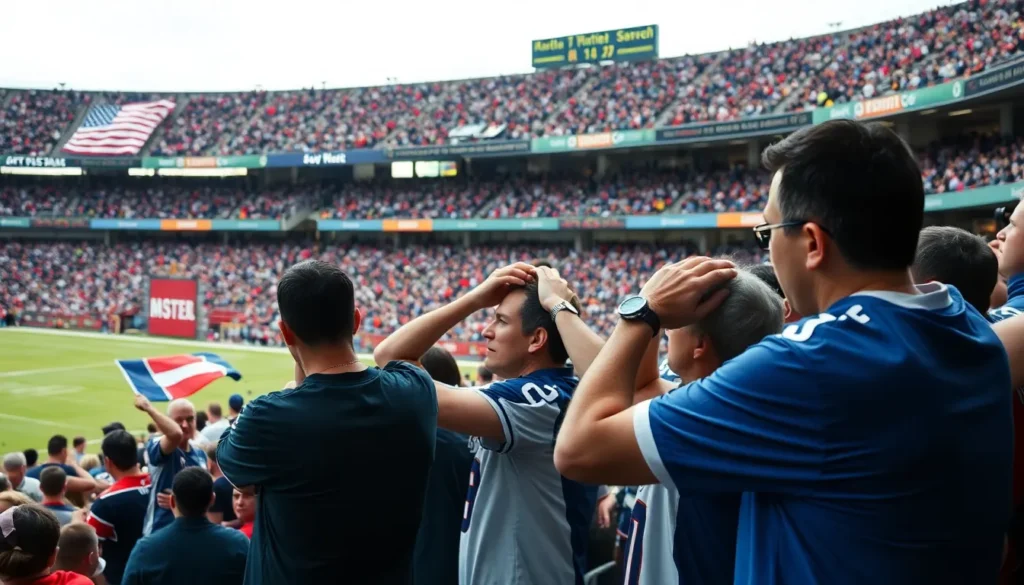Table of Contents
ToggleIn the world of sports, where passion runs high and rivalries ignite, nothing shatters the illusion of fair play quite like match-fixing scandals. Imagine tuning in to watch your favorite team only to discover that the outcome was as scripted as a soap opera. It’s enough to make even the most die-hard fans question their loyalty and the integrity of the game.
Overview of Match Fixing Scandals
Match fixing scandals represent a significant concern for the sports community. Scandals such as the 2006 Italian football scandal, where top clubs like Juventus faced severe penalties, illustrate the gravity of the issue. Numerous incidents across various sports reflect a growing trend that raises questions about game integrity.
Various stakeholders, including players, officials, and gambling syndicates, often play roles in orchestrating these scandals. In cricket, the 2010 spot-fixing scandal revealed how players could collaborate with betting rings to manipulate match outcomes. Trust in sports diminishes when fans discover that their favorite teams may not compete on equal footing.
In addition, federations and governing bodies struggle to establish measures to combat match fixing effectively. The International Cricket Council introduced strict penalties for players involved in fixing. Similarly, FIFA has implemented frameworks to ensure greater transparency and integrity in football.
Data shows that sports betting contributes to the prevalence of match fixing. Sports Integrity Unit reported that up to 1 in 5 professional matches may be susceptible to manipulation. This alarming statistic highlights the need for continuous vigilance against corrupt practices.
Educational initiatives targeting athletes and officials aim to raise awareness and prevent future incidents. These programs emphasize the consequences of match fixing, fostering a culture of integrity. Engagement between leagues, law enforcement, and regulatory bodies remains crucial in addressing the issue comprehensively.
Historical Context

Match-fixing has a long, tumultuous history that significantly impacts various sports. Over the years, several notorious scandals have shaped the landscape of competitive integrity.
Key Events in Match Fixing
Numerous incidents have captured public attention. The 2006 Italian football scandal stands out, implicating major clubs, including Juventus, in orchestrating match outcomes. Another highlighted event includes the 2010 cricket spot-fixing scandal, which tarnished the image of cricket and involved high-profile players from Pakistan. In addition, the 1994 NBA Finals faced scrutiny, where allegations of refereeing bias led to widespread speculation. These events emphasize the ongoing vulnerability of sports to manipulation and highlight the continuous struggle for integrity.
Evolution of Regulations
Regulations have evolved to address the persistent issue of match-fixing across sports. Early measures included the establishment of internal review boards within leagues. In recent years, organizations such as FIFA and the International Cricket Council have enacted stricter guidelines aimed at preventing manipulation. The introduction of educational initiatives is crucial; they target players and officials alike. Real-time monitoring systems have also gained traction, enhancing transparency. Consequently, collaborations between regulatory bodies and law enforcement agencies help combat this pressing issue more effectively.
High-Profile Cases
Major match-fixing scandals have significantly impacted the integrity of sports, showcasing the serious repercussions of unethical practices.
Case Study: The Calciopoli Scandal
In 2006, Italian football faced a major crisis with the Calciopoli scandal. Juventus emerged as the central figure, as club officials were accused of colluding with referees to manipulate match outcomes. Investigations revealed that select matches had officiating decisions influenced by favoritism, leading to Juventus being stripped of two Serie A titles. As a result, they received a relegation to Serie B, while other implicated teams faced penalties as well. The scandal shook Serie A and prompted the Italian Football Federation to implement stricter regulations and oversight.
Case Study: The Hansie Cronje Affair
The Hansie Cronje affair in 2000 exposed corruption in cricket. South African captain Hansie Cronje confessed to accepting bribes from bookmakers to manipulate match outcomes. Following an investigation, Cronje was banned for life by the International Cricket Council. Additionally, this scandal revealed the extent of betting syndicates’ influence on cricket, raising concerns about player integrity. The revelations prompted cricket boards worldwide to reassess their policies and strengthen measures against match-fixing.
Impact on Sports Integrity
Match-fixing scandals significantly tarnish the integrity of sports. These incidents create a ripple effect that damages trust among fans, players, and officials alike.
Consequences for Athletes
Athletes caught in match-fixing face severe repercussions. Penalties often include lifelong bans from competition, as seen with figures like Hansie Cronje. This loss of reputation affects not only the individual involved but also their teams and sponsors. Careers can abruptly end due to involvement in such scandals, resulting in financial ruin for some athletes. Engagement in match-fixing also leads to increased pressure from governing bodies to adhere to strict regulations. Many athletes experience emotional turmoil from the fallout, impacting their performance and mental health.
Reactions from Governing Bodies
Governing bodies respond to match-fixing with stringent measures. Organizations like FIFA and the International Cricket Council implement new policies to enhance compliance and transparency. These institutions often conduct in-depth investigations into allegations, aiming to restore faith in the integrity of sports. Increased collaboration with law enforcement agencies enables a more robust response to the issue. Educational programs are rolled out to inform athletes and officials about the dangers of match-fixing. Sanctions against offenders have become more severe, showcasing a zero-tolerance approach to this grave violation of sportsmanship.
Preventive Measures and Solutions
Addressing match-fixing involves multifaceted strategies focusing on technology and education. Stakeholders prioritize transparency and integrity through robust frameworks.
Role of Technology in Combatting Match Fixing
Technology serves as a critical tool in the fight against match-fixing. Real-time monitoring systems track unusual betting patterns, alerting authorities to potential manipulation. Data analytics identifies suspicious behaviors among players and officials, enhancing detection capabilities. Additionally, blockchain technology provides transparent records of match-related transactions, thereby increasing accountability. Embedded with security features, many platforms prevent unauthorized access and manipulation. Efforts to integrate artificial intelligence further improve the ability to predict and quickly respond to threats of corruption.
Educational Programs for Athletes
Educational programs play a vital role in preventing match-fixing. These initiatives equip athletes with knowledge about the risks and consequences of involvement in corrupt practices. Workshops cover topics like integrity, responsible gambling, and the legal ramifications of match-fixing. Collaboration with experienced former athletes and experts fosters a deeper understanding of sportsmanship. Emphasizing ethical behavior cultivates a culture of fairness, with programs often tailored to specific sports. Continuous education ensures athletes remain vigilant against potential threats from gambling syndicates, further strengthening the integrity of their respective sports.
Conclusion
Match-fixing scandals continue to pose a significant threat to the integrity of sports. The emotional impact on fans and athletes alike is profound as trust in the fairness of competition erodes. Stakeholders must remain vigilant in their efforts to combat this issue through education and collaboration.
The ongoing evolution of regulations and the integration of technology serve as crucial tools in the fight against match manipulation. By fostering a culture of transparency and integrity, the sports community can work towards restoring faith in the games that millions cherish. As the landscape of sports continues to change, a unified approach will be essential in safeguarding the future of fair play.







